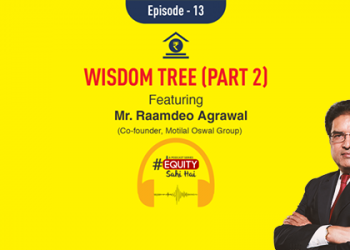Lord Ganesha, popularly known as Ganpati or Vinayaka is worshipped as a remover of obstacles, both of material and spiritual order. He is one of the most worshipped deities in the Hindu pantheon. Although he is known by many attributes; Lord Ganesha arguably offers very valuable lessons in a variety of fields. The distinct features of the various parts of his body hold a unique and significant meaning, which is also why the lord is known by various names.Read to know 5 Key financial lessons from Lord Ganesha;
Lambakarna – Listen out and loud

Lord Ganesha is also, fondly known as Lambakarna. This is because his large, elephant-like ears denote that one must have their ears open wide to absorb knowledge and act accordingly. A lot of information is easily available on various platforms and it is when you invest, it is absolutely essential to filter the information or advice you’re receiving. Also, investing sometimes can be quite tricky when one is perhaps, new to investing or has mixed thoughts. This is when we should consult a financial advisor and listen to his/her advice thoroughly and carefully as he has ample expertise in the financial domain.
Gajanana – Think big, to achieve bigger

The elephant-headed lord, as explanatory it is; has a huge head. This is primarily why, he is also known as Gajanana. This signifies that one should always think big. Looking at it from a financial perspective, this lesson can be applied to the investment space as well. So, when we are beginning to chart out a financial plan, one must identify all the goals one aims to achieve. Financial goals can be segregated to short, medium and long-term goals. Goals can be met when they are prioritised well. For instance; if buying a car is your long-term financial goal, then perceive that as the big picture and focus to achieve that. Financial goals can vary individually; for instance a vacation abroad, children’s education plan, contingency/insurance or retirement etc.
Chinteshwara – Concentrate and maintain your focus

Lord Ganesha, despite having a large head and body; has small eyes signify looking at the details with concentration. This is why he is known as Chinteshwara. Post looking at the big picture, it is extremely essential to identify the nitty-gritty and diligently focus on the minute details. Similarly while investing, once the financial goals have been identified, we should carefully work towards achieving them. Do an extensive research on the financial instrument you wish to invest in. Observe their pros and cons, suggestively; one must opt for a focused portfolio. Once through with the entire process, promise to yourself to stay focused and invested. One must not deviate from the set agenda and allot a stipulated time frame to accomplish their financial missions.
Vakratundaya – Trunk-like patience to adapt in all conditions

Lord Ganesha’s trunk, which is why he is also known as Vakratundaya symbolise that one must possess the righteousness of patience and adapt to inimical conditions, since things may not always be way we wish them to be. Taking this into account, during our course of investing, market conditions may not always be favourable; market volatility may affect your investments, but one must never forget that the sky eventually clears for bright and beautiful rainbow. Here is when, investors must realize that market volatility or corrections may happen, but they should be calm and adapt to the changing conditions, and eventually everything will return to normalcy, and perhaps, bring sweet returns too.
Ekadantaya – Strong tusk power to fork out bad investments

Lord Ganesha, customarily known as Ekadantaya, referring to the strength and power of his tusks suggest that in life, one must possess the strength to take right decisions and act unemotionally to be able to eliminate bad and negative influences. Similarly, one must have the sense and strength to fork out poorly performing investments that hold back the potential of the portfolio.












































